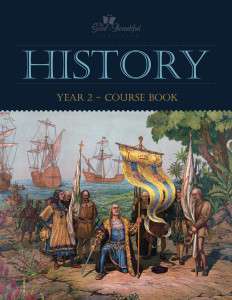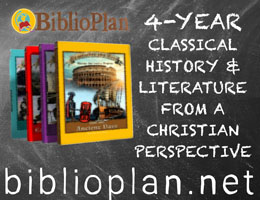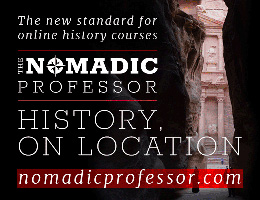The Good and the Beautiful History Curriculum (GBHC) is a multi-level, interactive curriculum that incorporates stories and hands-on activities. The curriculum is designed for the family to use together, covering grades 1 through 12. It is has a significant amount of biblical content and emphasizes both Christian character and patriotism.
GBHC draws its historical material from more than 40 history books that were written during the late 1800s and early 1900s. While older source material has been used, it has been rewritten somewhat for modern audiences and combined with additional, newly-written material.
The program consists of four history courses: Year 1, Year 2, Year 3 and Year 4. The four-year cycle can be repeated two or three times to cover all grade levels. Each course is presented in four units and covers some world history and some U.S. history each year.
The first unit in Year 1 begins with biblical history and ancient Egyptian history. The second unit jumps up to the Middle Ages and the Renaissance. The third unit shifts to U.S. history covering the French and Indian War up through the Revolutionary War. The fourth unit broadens out to world history, covering selected events from the Victorian era up through the fall of the Soviet Union.
In Year 2, students learn about ancient Greece and ancient Asia in the first unit. The second unit begins with the Vikings and Marco Polo and continues through some of the major explorers of the 15th and 16th centuries. In the third unit, students study U.S. history, focusing on the colonial period and the U.S. Constitution. The fourth continues U.S. history with selected topics such as Education in Early America, Noah Webster, Henry Ford, and the Great Depression, and it also has five lessons on World War I.
Year 3 covers ancient Mesopotamia and ancient Israel in the first unit. Interestingly, the course teaches about the Code of Hammurabi in one lesson and about the Ten Commandments in the next. At the same time, students begin playing the Bill of Rights Roundup game that is part of this course. While I don't see instructions that have older students compare and contrast any of them, their close juxtaposition makes this relatively easy to do. In the second unit, students learn about ancient Africa and native North Americans. The third unit addresses several U.S. history topics, including the Industrial Revolution, westward expansion, and five key people: Daniel Boone, George Washington Carver, Samuel Morse, and Thomas Edison. The final unit is on World War II.
Year 4 begins with ancient Rome, but it also covers the Roman Republic and the Roman Empire, the spread of Christianity, the Byzantine Empire, the history of Islam, Charlemagne, and the Crusades. Unit 2 covers the Reformation and the history of the Bible. Slavery and the U.S. Civil War are topics for the next unit, and the final unit covers selected topics from modern history such as women's suffrage, Mahatma Gandhi, the African American civil rights movement, the War on Terror, Mother Teresa, and modern technology. The Year 4 game, called History Houses, will review units from Years 1 through 4 and will be the only suggested game in Year 4. While the publisher says, "Every effort has been taken to create a sensitive and neutral approach to the Protestant Reformation and Catholic Counter-Reformation..." ( p. 44), the second unit still comes across as if written from a Protestant viewpoint.
As I’ve mentioned, coverage is selective since it is often told through expansive stories and biographies rather than the snippets of facts commonly used in history textbooks. History stories are presented along with instructions to make lessons more interactive. For example, Year 1, Lesson 44 is about the Battle of Trenton, and the lesson begins with children observing and discussing the reproduction of a painting, The Battle of Trenton. Then a simple activity has children stand barefoot on an ice cube as long as they can to experience just a bit of the cold that George Washington’s soldiers did in that battle. (Don't let your children overdo this to try to prove their stoicism!) The story is then read aloud to children from the Course Book. The story is interrupted twice for the parent to ask children to summarize the story up to that point, a form of narration. This happens again at the end, followed by four discussion questions. This lesson format is typical for the presentation of the stories throughout the program.
A Course Book is the heart of each course. It has bold text with instructions for the parent, while normal text is to be read aloud to students.
You also will use the Student Explorer files that suit your children. There are four different levels of Student Explorer files to help differentiate assignments and make them age-appropriate. The levels are grades 1-3, grades 4-6, grades 7-9, and grades 10-12. You will need to print out the Student Explorer for each student from a downloaded file and put it in a three-ring binder. (Students in seventh grade and above will also compile a history notebook.) The Course Book shows when to use Student Explorer files, play the games that are used with each course, participate in activities, work on long-term projects, etc.
Parents read aloud to students from the Course Book and from a book of stories when there is one for the course. In addition, parents will choose a read-aloud book from among a number of recommended titles for each quarter.
For each course, there are high-quality, dramatized audio recordings of history stories that are accessed online. They address the same historical periods as the rest of the course for which they were created, but they do so with different stories than in the other books for the courses. These audio stories vary in length from about seven to eleven minutes each, so they are just the right length to hold students’ attention. They should not be skipped since they add additional course content.
For Year 1, in addition to the Course Book, Student Explorer files, and dramatized audio recordings (accessed online), you need The Big Book of History Stories and the Keys of History Board Game. Read-aloud recommendations for this course include books such as The Golden Goblet by Eloise Jarvis McGraw.
Year 2 differs slightly from Year 1. The book Maps and Images is used rather than a book of history stories. While the Course Book refers to the Keys of History Board Game, another game, Explorers and Settlers, is added the second year. If you have Keys of History, it can be used at the suggested time to review material learned last year. (You can order Keys of History separately if you don’t already have it, but it isn’t essential for Year 2.) A timeline with stickers has been added beginning with Year 2. It includes some stickers for events from Year 1 that can be used as a form of review.
Year 3 uses the companion book The Big Book of History Stories that includes maps and images. You will use the same timeline from Year 2 with Years 3 and 4, and you receive new sets of stickers to add each year. While Year 3 adds the Bill of Rights Roundup game, it also recommends playing the games from previous years for review.
With students up through fifth grade, you should complete about two lessons per week—one course per year. With older students, you should plan to use about three lessons per week, which means that you would complete each course in about 20 weeks. If you use a course with both younger and older students and want to keep them on the same schedule, you might add additional reading, research, and written reports for older students rather than covering material at a faster pace.
Course work for each lesson varies according to the level of the Student Explorer that students are using. For one course, the Student Explorer for the youngest level has only 29 pages with many simple activities such as coloring and drawing whereas the oldest level has 63 pages and requires additional reading, research, and writing.
Lesson structure varies from day to day. On some days you will read aloud a history story directly from the Course Book. You might also listen to audio dramatizations or read the script of the audio drama. Discussion questions in the Course Book often follow the reading and listening activities. On some days you might be reading a story or doing map work in one of the other books for a course. Children work on Student Explorer activities throughout the week. The Course Book advises you when children should be doing additional research or preparing to make oral presentations. Craft activities for each course are generally fairly simple and often use reproducible pages from the Course Book. Year 1 also includes some memorization activities. All of the courses include multi-sensory learning activities, but they are not extremely time-consuming.
The games for these courses serve as tools for review and reinforcement. The games are surprisingly compact, but they are well-constructed with sturdy game boards and game components. The Keys of History game has a 10-inch game board, playing pieces, and a deck of cards. Each of the cards has information from a key topic covered in the course. The instructions include various ways to play the game to make it suitable for different ability levels. The Explorers and Settlers game used in Year 2 is a card game that plays like a sophisticated form of a memory card-matching game. Players find matching cards, but they must also identify famous explorers or settlers from descriptions on the cards. The Bill of Rights Roundup game is somewhat similar to The Keys of History game with a 10-inch game board, playing pieces, a deck of cards, and instructions for a few variations for play.
There are no tests for The Good and the Beautiful History Curriculum. Older students will be completing history notebooks and other work that can be used for evaluation and grading purposes, but parents will need to figure out how to evaluate the work on their own.
The Course Books explain that students should cycle through the four courses again as they get older. They will encounter different assignments in their Student Explorers each time through. While I like the story approach to history, I think that more comprehensive coverage is vital somewhere along the line. Repetition is certainly useful, but I think it might be more productive to expand into other topics rather than repeat so extensively. I’d be most likely to use GBHC for grades one through eight, then switch to something else for high school. The publisher is aware of this issue, and they tell me that they are in the development and writing process for high school history courses that they plan to release in the future. The present program will remain available for families that prefer to do their history together as a family. The new high school history courses will be part of their own Green Leaf High School and will be what they recommend for high school students at that point. Those who want to stick with the present program should supplement for high schoolers to provide more comprehensive coverage.
While biblical and Christian history is included, GBHC does not promote any single denomination. Protestants and Catholics are both treated with respect although information leans slightly in a Protestant direction as evidenced, for example, by their treatment of the Reformation. But at the same time, there are entire lessons on Catholic historical figures such as St. Patrick and Joan of Arc. When quotations from the Bible are used, they are from the King James Version of the Bible. A free PDF supplement is available for members of The Church of Jesus Christ of Latter-day Saints.
GBHC also reflects a conservative political outlook that shows up from time to time. On the publisher’s website it explains:
These history courses teach conservative principles such as limited government, keeping the power as close to the people as possible, self-reliance, avoiding entitlements, and the role of government as providing protection and not goods.
All components except the games are available as either PDF downloads or physical products. Physical Course Books are printed in black and white; since you will need to copy or print some activity pages, I think that a PDF Course Book should work well for most situations. The physical versions of the Big Book of History Stories and Maps and Images are both lovely, full-color books, but viewing the PDF versions on a screen should work well. I definitely recommend purchasing a printed set of the timeline and stickers.
Summary
The Good and the Beautiful History Curriculum is relatively easy to use given the wide variety of learning methods involved. Course Books clearly show what to do when, making it easy for even new homeschoolers to use. While other publishers use a similar story-based approach for teaching history, the fact that GBHC has worked hard to make it suitable for a broad Christian audience makes it appealing for many families.










